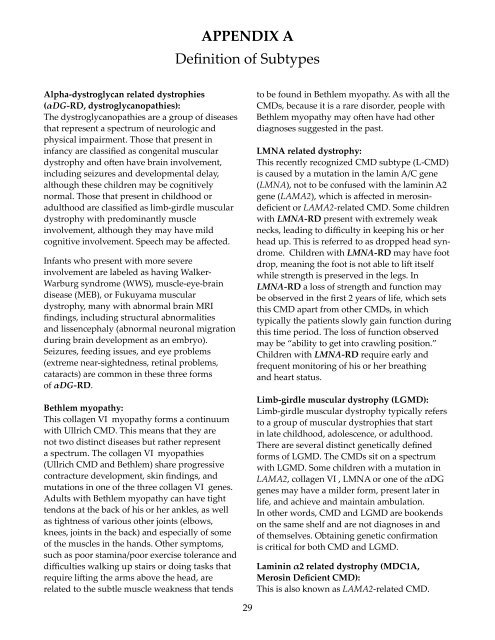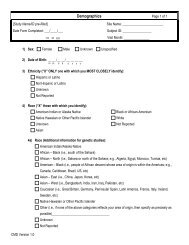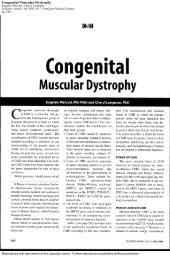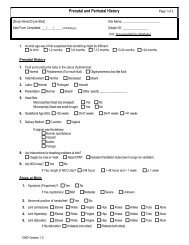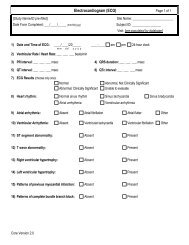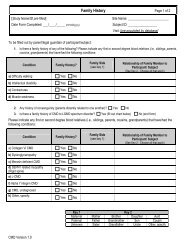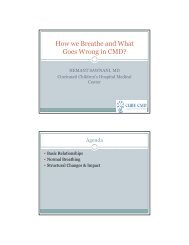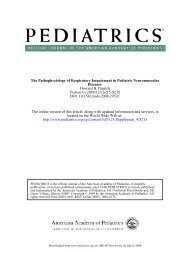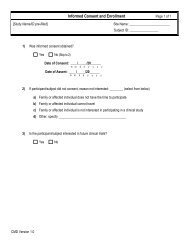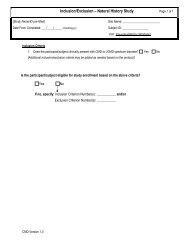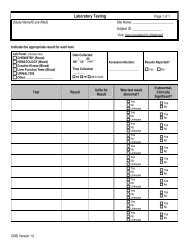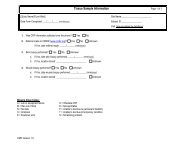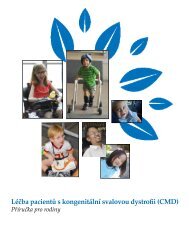The Management of Congenital Muscular Dystrophy ... - Cure CMD
The Management of Congenital Muscular Dystrophy ... - Cure CMD
The Management of Congenital Muscular Dystrophy ... - Cure CMD
Create successful ePaper yourself
Turn your PDF publications into a flip-book with our unique Google optimized e-Paper software.
APPENDIX ADefinition <strong>of</strong> SubtypesAlpha-dystroglycan related dystrophies(αDG-RD, dystroglycanopathies):<strong>The</strong> dystroglycanopathies are a group <strong>of</strong> diseasesthat represent a spectrum <strong>of</strong> neurologic andphysical impairment. Those that present ininfancy are classified as congenital musculardystrophy and <strong>of</strong>ten have brain involvement,including seizures and developmental delay,although these children may be cognitivelynormal. Those that present in childhood oradulthood are classified as limb-girdle musculardystrophy with predominantly muscleinvolvement, although they may have mildcognitive involvement. Speech may be affected.Infants who present with more severeinvolvement are labeled as having Walker-Warburg syndrome (WWS), muscle-eye-braindisease (MEB), or Fukuyama musculardystrophy, many with abnormal brain MRIfindings, including structural abnormalitiesand lissencephaly (abnormal neuronal migrationduring brain development as an embryo).Seizures, feeding issues, and eye problems(extreme near-sightedness, retinal problems,cataracts) are common in these three forms<strong>of</strong> αDG-RD.Bethlem myopathy:This collagen VI myopathy forms a continuumwith Ullrich <strong>CMD</strong>. This means that they arenot two distinct diseases but rather representa spectrum. <strong>The</strong> collagen VI myopathies(Ullrich <strong>CMD</strong> and Bethlem) share progressivecontracture development, skin findings, andmutations in one <strong>of</strong> the three collagen VI genes.Adults with Bethlem myopathy can have tighttendons at the back <strong>of</strong> his or her ankles, as wellas tightness <strong>of</strong> various other joints (elbows,knees, joints in the back) and especially <strong>of</strong> some<strong>of</strong> the muscles in the hands. Other symptoms,such as poor stamina/poor exercise tolerance anddifficulties walking up stairs or doing tasks thatrequire lifting the arms above the head, arerelated to the subtle muscle weakness that tendsto be found in Bethlem myopathy. As with all the<strong>CMD</strong>s, because it is a rare disorder, people withBethlem myopathy may <strong>of</strong>ten have had otherdiagnoses suggested in the past.LMNA related dystrophy:This recently recognized <strong>CMD</strong> subtype (L-<strong>CMD</strong>)is caused by a mutation in the lamin A/C gene(LMNA), not to be confused with the laminin A2gene (LAMA2), which is affected in merosindeficientor LAMA2-related <strong>CMD</strong>. Some childrenwith LMNA-RD present with extremely weaknecks, leading to difficulty in keeping his or herhead up. This is referred to as dropped head syndrome.Children with LMNA-RD may have footdrop, meaning the foot is not able to lift itselfwhile strength is preserved in the legs. InLMNA-RD a loss <strong>of</strong> strength and function maybe observed in the first 2 years <strong>of</strong> life, which setsthis <strong>CMD</strong> apart from other <strong>CMD</strong>s, in whichtypically the patients slowly gain function duringthis time period. <strong>The</strong> loss <strong>of</strong> function observedmay be “ability to get into crawling position.”Children with LMNA-RD require early andfrequent monitoring <strong>of</strong> his or her breathingand heart status.Limb-girdle muscular dystrophy (LGMD):Limb-girdle muscular dystrophy typically refersto a group <strong>of</strong> muscular dystrophies that startin late childhood, adolescence, or adulthood.<strong>The</strong>re are several distinct genetically definedforms <strong>of</strong> LGMD. <strong>The</strong> <strong>CMD</strong>s sit on a spectrumwith LGMD. Some children with a mutation inLAMA2, collagen VI , LMNA or one <strong>of</strong> the αDGgenes may have a milder form, present later inlife, and achieve and maintain ambulation.In other words, <strong>CMD</strong> and LGMD are bookendson the same shelf and are not diagnoses in and<strong>of</strong> themselves. Obtaining genetic confirmationis critical for both <strong>CMD</strong> and LGMD.Laminin α2 related dystrophy (MDC1A,Merosin Deficient <strong>CMD</strong>):This is also known as LAMA2-related <strong>CMD</strong>.29


